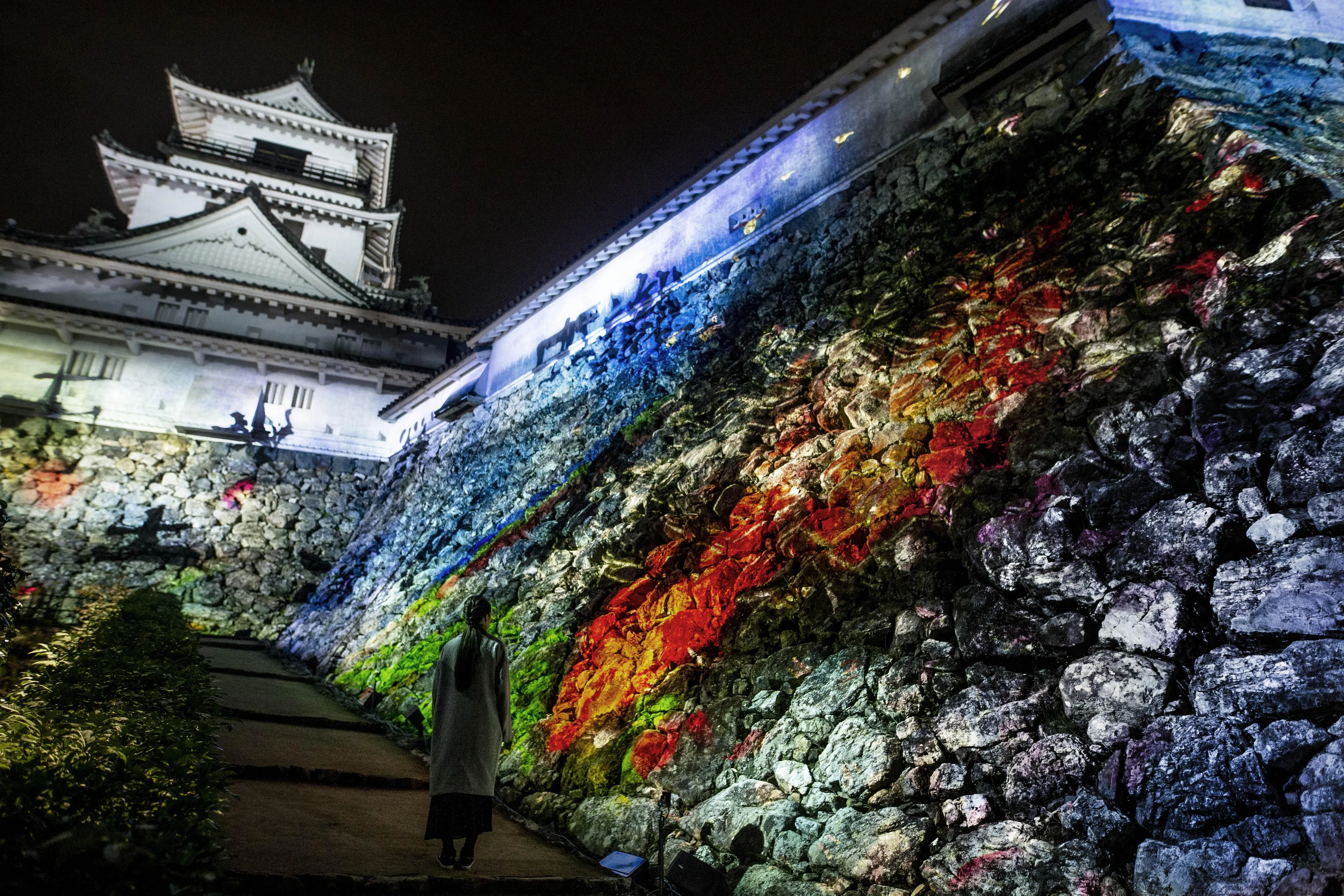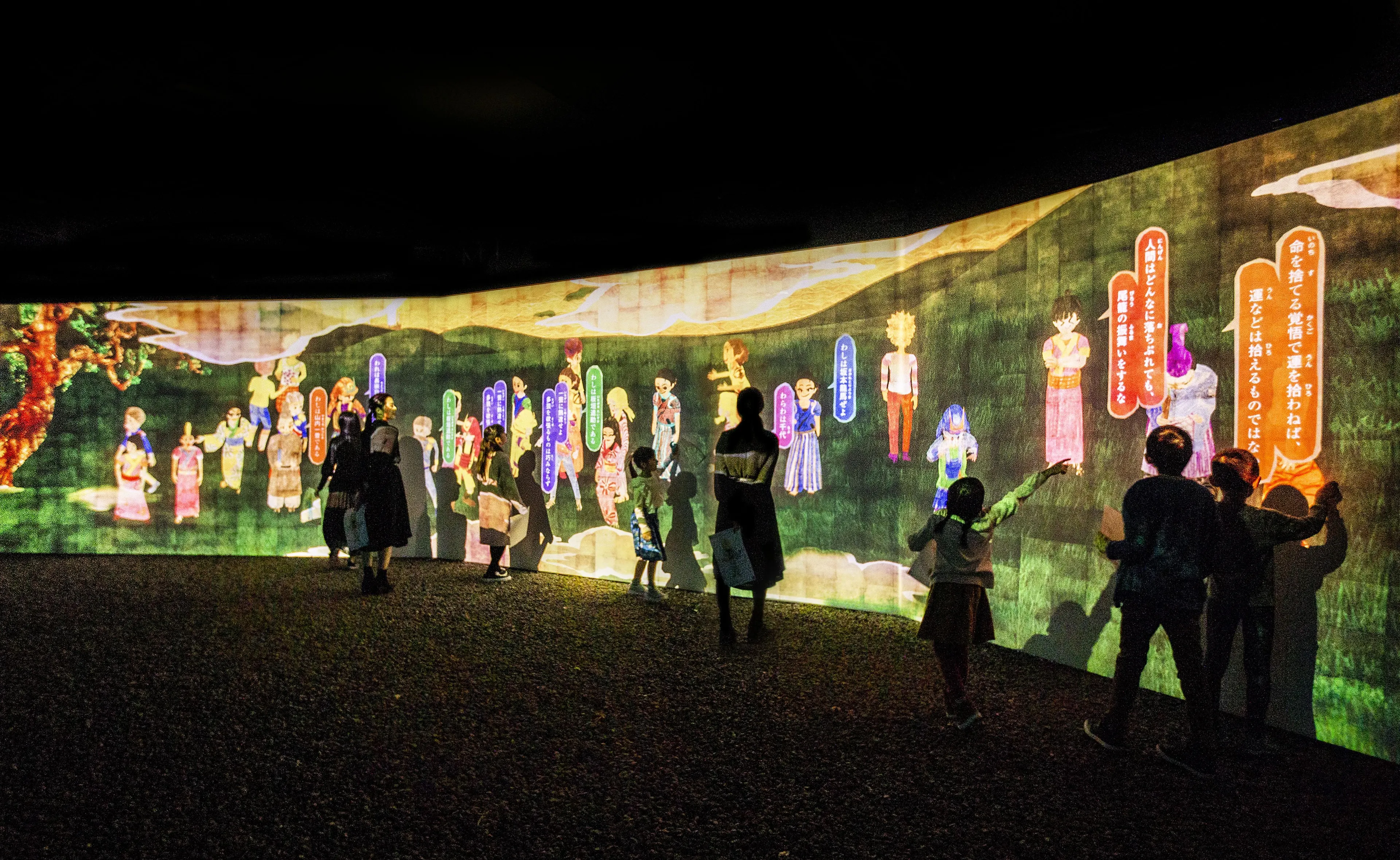teamLab: Digitized Kochi Castle

전시 종료
2019.11.08(Fri) - 2020.1.13(Mon)Kochi Castle, Kochi
Within Kochi Castle, there are many dark or unlit areas. Visitors are advised to wear clothes and footwear that are easy to move in for safety.

전시 종료
2019.11.08(Fri) - 2020.1.13(Mon)Kochi Castle, Kochi
Within Kochi Castle, there are many dark or unlit areas. Visitors are advised to wear clothes and footwear that are easy to move in for safety.
teamLab: Digitized Kochi Castle
Kochi Castle was built over a period of about 10 years starting in 1601. Despite it being destroyed in a fire, it was rebuilt in the middle of the Edo period and restored to its original form. Kochi Castle is considered an important historical site in Japan, as it is the only castle where the castle tower and nearly all of the central structure remain intact.
This exhibition is a part of teamLab’s Digitized City art project. The concept behind the project is that non-material digital technology can turn a city into art without physically altering it.
Kochi Castle has stood from the Edo period to the present day and remains an important symbol for the city of Kochi. teamLab: Digitized Kochi Castle will transform the castle into an interactive digital art space that changes due to the presence of people. This in turn, enhances the presence of humans, and transforms the relationship between people in the same space with digital art.
This exhibition is a part of teamLab’s Digitized City art project. The concept behind the project is that non-material digital technology can turn a city into art without physically altering it.
Kochi Castle has stood from the Edo period to the present day and remains an important symbol for the city of Kochi. teamLab: Digitized Kochi Castle will transform the castle into an interactive digital art space that changes due to the presence of people. This in turn, enhances the presence of humans, and transforms the relationship between people in the same space with digital art.
작품
teamLab에 대해
아트 컬렉티브 teamLab은 2001년 활동을 시작했다. 국경을 넘어선 연대 속에 집단 창작의 방식으로 예술, 과학, 테크놀로지 그리고 자연계의 교차점을 학제적 접근으로 모색한다. 아티스트, 프로그래머, 엔지니어, CG 애니메이터, 수학자, 건축가 등 다양한 분야의 전문가들로 구성된 teamLab은 예술을 통해 인간과 자연, 개인과 세계의 새로운 관계를 탐구하고 표현한다.
teamLab은 우리에게 익숙한 모든 경계에 대해 질문한다. 인간은 각자를 둘러싼 바깥 세상을 감각 기관으로 인지해 스스로와 분리하고 낱낱을 경계지어 독립체로 구분하려 한다. 현대 문명은 그런 방식으로 세계를 이해해 왔다. teamLab은 예술을 통해 감각을 확장하고 개인과 세계의 경계, 시간의 연속성에 대한 인지의 경계를 넘어설 수 있다고 믿는다. 이 세계의 모든 것은 광대한 시간 속에, 생명의 끝없는 연속 안에 가까스로, 하지만 기적적으로 존재하고 있다.
teamLab의 작품은 시드니 뉴사우스웨일스 주립 미술관, 애들레이드 사우스오스트레일리아 미술관, 샌프란시스코 아시아 미술관, 뉴욕 아시아 소사이어티, 이스탄불 보루산 현대 미술관, 멜버른 빅토리아 국립 미술관, 헬싱키 아모렉스가 영구 소장하고 있다.
teamlab.art
Biographical Documents
teamLab is represented by Pace Gallery, Martin Browne Contemporary and Ikkan Art.
MAP
전시회장 정보
teamLab: Digitized Kochi Castle 2019-2020
기간
2019.11.08(Fri) - 2020.1.13(Mon)
관람 시간
17:30 – 21:30 (Last entry 21:00)
관람료
Exhibition Admission:
Early Bird
Available at Convenience Stores in Japan
(Seven-Eleven, LAWSON, Mini stop, Family Mart)
[Number] 0252237 * Common number among all convenient stores above.
[Item] teamLab: Digitized Kochi Castle Early Bird Ticket
[Sales Period] October 15 (Tue) - November 7 (Thurs), 2019
Same Day Ticket
Available at on site and Convenience Stores in Japan
(Seven-Eleven, LAWSON, Mini stop, Family Mart)
[Number] 0252238 * Common number among all convenient stores stated above.
[Item] teamLab: Digitized Kochi Castle Same Day Ticket
[Sales Period] November 8 (Fri), 2019 - January 13 (Mon), 2020
Castle Tower Admission:
Only sold on site.
Early Bird
Available at Convenience Stores in Japan
(Seven-Eleven, LAWSON, Mini stop, Family Mart)
[Number] 0252237 * Common number among all convenient stores above.
[Item] teamLab: Digitized Kochi Castle Early Bird Ticket
[Sales Period] October 15 (Tue) - November 7 (Thurs), 2019
Same Day Ticket
Available at on site and Convenience Stores in Japan
(Seven-Eleven, LAWSON, Mini stop, Family Mart)
[Number] 0252238 * Common number among all convenient stores stated above.
[Item] teamLab: Digitized Kochi Castle Same Day Ticket
[Sales Period] November 8 (Fri), 2019 - January 13 (Mon), 2020
Castle Tower Admission:
Only sold on site.
Contact
오시는 길
주소
Kochi Castle
Kochi Park, 1-2-1 Marunouchi, Kochi City, Kochi
Kochi Park, 1-2-1 Marunouchi, Kochi City, Kochi
・15 min from Kochi Interchange by car.
・10 min from JR Kochi Station by car.
*For parking, please use the Kochi Park parking lot or the surrounding toll parking lots.
・3 minute walk from "Kochijo mae" Tosaden Kotsu tram stop
* From JR Kochi Station, switch tram at Harimayabashi.
Notes
・Kochi Castle and Kochi Park have stairs and unpaved roads. Due to the Law for the Protection of Cultural Properties, there are no access ramps.
・Visitors who come to the event drunk or otherwise pose a danger to themselves or others will be asked to leave.
・The exhibition may be closed due to severe weather.
・Entrance restrictions will apply if the venue reaches full capacity.
・The Organizers will not be held responsible for any injury, loss, or damage to personal items.
・Under no circumstances will refunds, exchanges or reissues be made after purchase.
・Visitors who come to the event drunk or otherwise pose a danger to themselves or others will be asked to leave.
・The exhibition may be closed due to severe weather.
・Entrance restrictions will apply if the venue reaches full capacity.
・The Organizers will not be held responsible for any injury, loss, or damage to personal items.
・Under no circumstances will refunds, exchanges or reissues be made after purchase.
주최자
teamLab: Digitized Kochi Castle Executive Committee






















